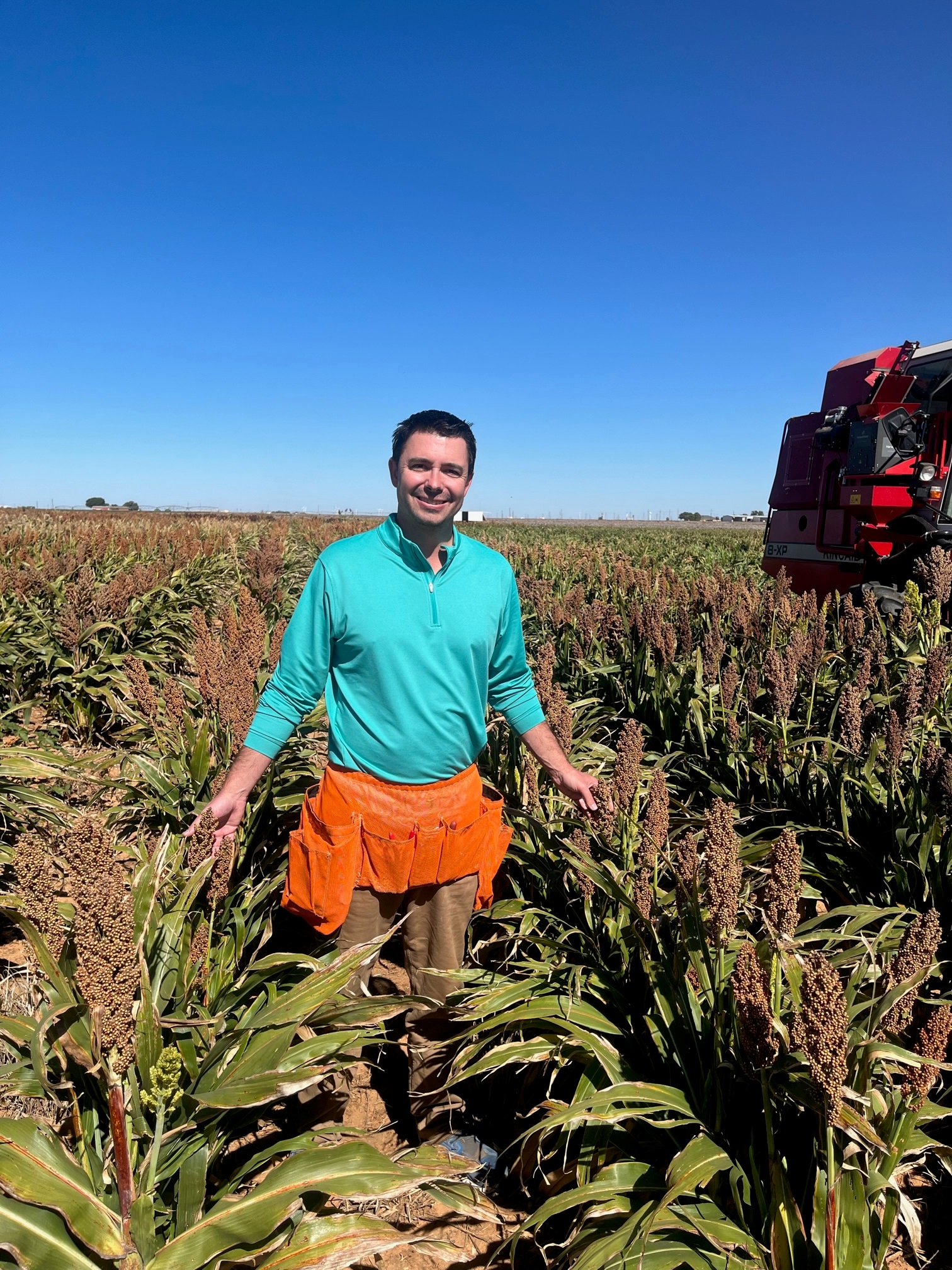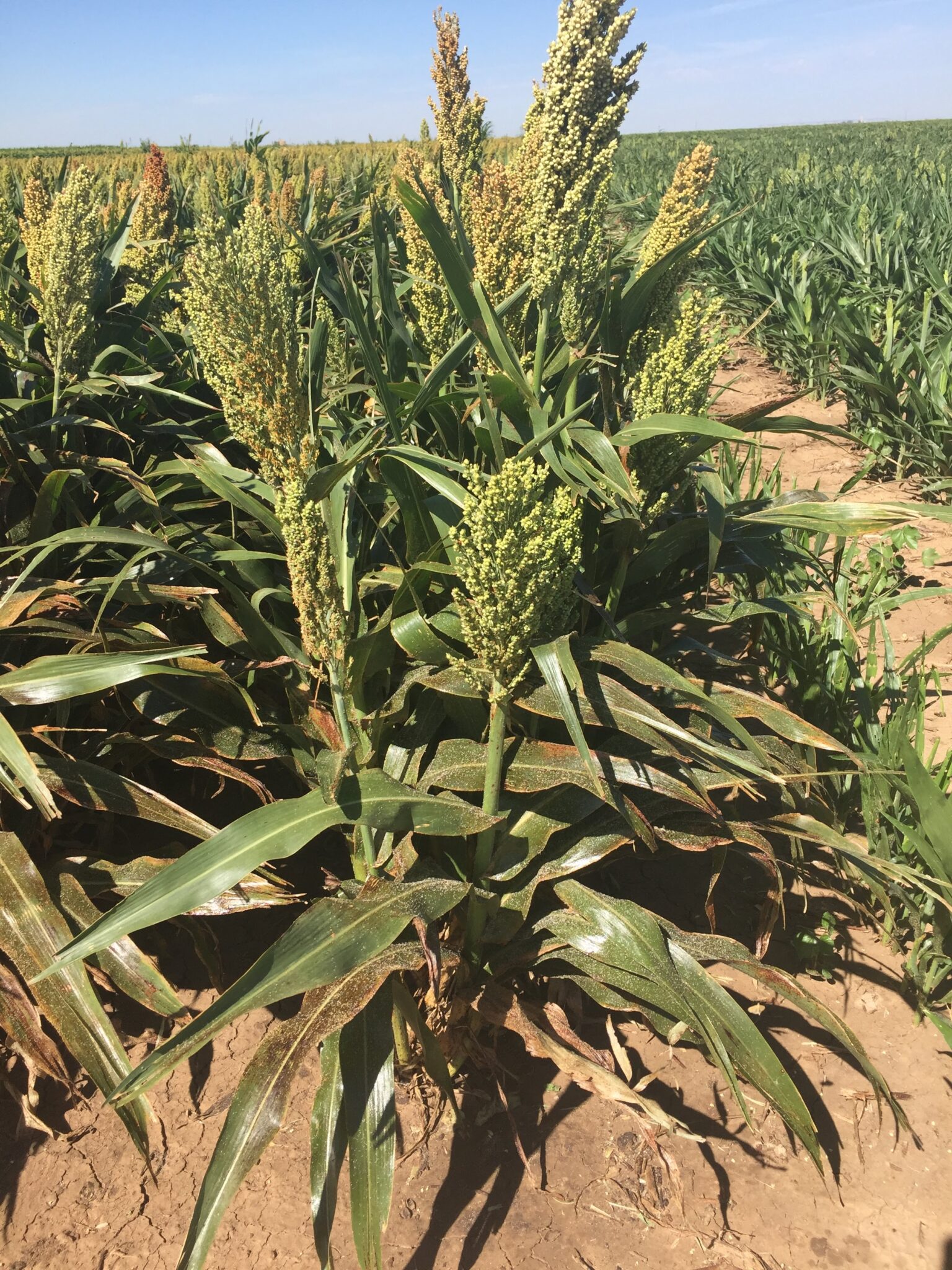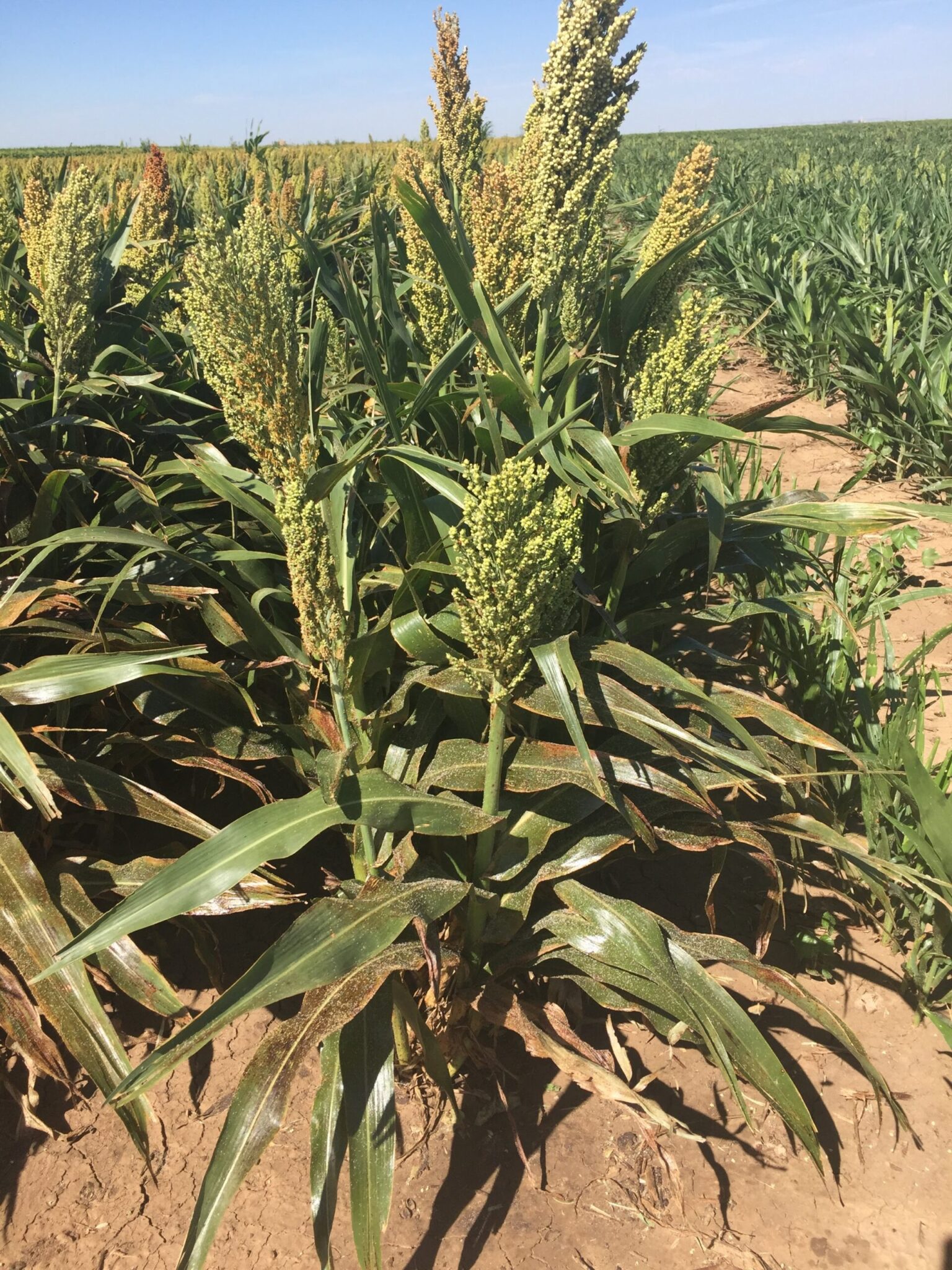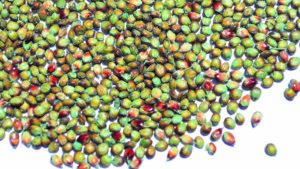Fighting back on the farm with genetic resistance
There is good news and bad news for sorghum growers. The good news is that they no longer need to worry about sugarcane aphid. The bad news is that they do need to continue protecting their sorghum crops against aphid: what was previously thought to be sugarcane aphid in sorghum crops actually is sorghum aphid, recently confirmed via genetic testing to be a distinct species.
“This has taken five or six years to figure out that this is not the same species,” says Brent Bean, agronomy director for the United Sorghum Checkoff Program.
Bean says the two pests look essentially identical; however, they possess enough genetic differences and slight morphological differences to separate the sorghum aphid, Melanaphis sorghi, from the sugarcane aphid, Melanaphis sacchari.
David Kerns, Texas A&M University entomologist, says the most significant difference between the two pests is their host range and host preference.
“You can’t tell the difference with the naked eye so the main thing to know is that if it’s in sorghum, it’s the sorghum aphid,” he explains “A true sugarcane aphid doesn’t do well on sorghum, and vice versa.”
Initial efforts
While the enemy may have changed names, the battle continues.
Researchers detected the sorghum aphid in Texas in 2013. Large populations led to significant crop losses and just two years later, the sorghum aphid was reportedly present in 17 states, as well as in Mexico.

Texas A&M AgriLife Extension research in the 2015 Journal of Agricultural and Applied Economics estimated the mean economic loss from sorghum aphid was just over $64 per acre.
“When aphids hit the sorghum industry, it was really a significant problem, decimating millions of acres,” says Chad Hayes, a sorghum breeder with the Agricultural Research Service of the U.S. Department of Agriculture.
“The sorghum producers took the big hit,” Bean says. “Aphids essentially destroyed the crop in years when infestations were highest, and growers couldn’t afford to make multiple insecticide applications. That meant we really did need to have better hybrids.”
The industry came together and fortunately quickly discovered some existing sorghum lines with some level of resistance.
“At that time, in a field where sorghum was susceptible, the entire crop was devastated with basically no grain yield so the fields that had resistance were obvious because while aphids were present, the plants were still alive and had yield,” Hayes says.
Agronomists, entomologists and breeders spent the next several years evaluating hundreds of sorghum hybrids and finding the few that could resist, while also working to identify and incorporate the source of that resistance into other hybrids.
Terry Felderhoff, Kansas State University research assistant professor, says the primary reason for identifying the resistance gene was the exchange of germplasm and knowledge.
“The initial source of the resistance came from sorghum germplasm exchange from Ethiopia, along with knowledge exchange from Haiti, China, and southern Africa,” he explains. “Sharing of these resources enabled everyone to leverage and aid each other in identifying a primary source of genetic resistance.”
Resistance vs tolerance
Texas A&M AgriLife Extension, recommends a threshold of 20 to 30% of plants infested with 50 or more aphids per leaf.
“Non-resistant varieties were hitting those thresholds in as little as two or three days,” Bean says.

Scientists first identified resistant varieties in 2015 that were able to withstand aphid attack for much longer, preventing aphid populations from as quickly reaching those thresholds. This allowed growers more time to scout fields and get insecticides applied when aphids were present.
However, the United Sorghum Checkoff Program and others in the industry call these varieties tolerant rather than resistant, because they aren’t resistant in the way growers usually understand the word.
“These hybrids are not completely resistant in the way that Bt corn and other crops like that are, when you plant the seed and essentially don’t have to worry about it,” Bean says.
Bean explains that pest tolerance occurs when the plant simply tolerates more aphids without a loss of health and yield. Conversely, true resistance can come from either antixenosis, (or non-preference), which occurs when the pest no longer desires the plant due to odor, texture or color; or antibiosis, when the plant itself causes injury, reduced longevity or reduced reproduction of the pest.
“The current primary resistance is caused by antibiosis, meaning it physically affects the aphid as opposed to just changes their behavior, such as altering their preference for the plant,” Felderhoff says.
“Research shows that this antibiosis reduces the aphid population growth rate by around a half.”
Because this reduction is not complete enough to remove all risk to the plant, Bean explains the intentional shift in wording.
“We used the term tolerant so growers would know that resistance, in this case, doesn’t mean they won’t need an insecticide,” Bean says. “They may very well have to still use one, but hopefully only once, and they will have more time before they reach that threshold.”
Genetic gains
Researchers have been diligently working to breed resistant varieties.
“Multiple research programs have identified that gene to be RMES1 on chromosome 6,” Hayes says. “That’s the gene for the source of resistance that the U.S. sorghum industry is using and it’s working very well.”
Breeders use molecular markers to track resistance. The marker is a KASP (kompetitive allele-specific polymerase chain reaction) marker, which allows breeders to add resistance to existing varieties.

“Not only can we use that marker to find resistance in breeding programs, but if a company has a product on the market now with high yield that does not have aphid resistance, with this marker and the technology we have available to us, they can integrate that resistance into current products,” Hayes says.
This reduces the risk of yield drag in resistant offerings.
“Typically, anytime you incorporate resistance to a pest, it often comes from a source that is not as high yielding or has other agronomic problems,” Hayes explains. “But, using this marker to introgress resistance into their current products reduces that risk.”
Management matters
While research gains are important, so too are growers’ efforts to manage the risks.
“When the sorghum matures around soft dough, the resistance to sorghum aphid isn’t as good as earlier and we can see aphid population growth, [so there’s a] need to spray to avoid harvest issues,” Kerns says, noting that scouting and planting dates are crucial to success. “Growers have become very efficient at management so that we don’t have large populations building in the field. If you’re able to plant early, you can avoid a lot of sorghum aphid problems.”
Bean says there currently are three main insecticide products available. Initially growers only had two insecticides, Transform and Sivanto Prime, which both act, although differently, at the nicotinic acetylcholine receptor.

“That makes us a little nervous. But fortunately, we now have another product — Sefina — which is a completely different mode of action,” Bean says. “That gives us reassurance that if the aphid becomes resistant to one of the insecticides, we will still have an insecticide option to go along with hybrid tolerance.”
Hayes says relying on natural predator bugs is even better, though unreliable.
“Beneficial insects are great but hard to control,” he adds. “Anytime we can use genetic resistance, it’s going to be the first and safest approach.”
Future focus
Researchers emphasize it’s important to remember that thus far, this aphid fight has largely been fought on the battleground for grain sorghum.
“Because a lot of forage sorghum is used on farm for cattle production, the reporting and numbers aren’t always there, but we know we currently have less resistance in forage,” Hayes says.
However, Hayes explains there are forage sorghum hybrids on the market with sorghum aphid tolerance and the two industries continue to work together.
“Nearly everything learned about sorghum aphid resistance in grain sorghum is transferable to forage sorghum, and nearly all sorghum forage breeding programs are working with resistance breeding,” Felderhoff says.
“The donor source of resistance is a public line, TX2783, and that’s a grain sorghum that by chance was a good source,” Hayes says. “The forage varieties didn’t have that so they were starting more from scratch and that’s where molecular breeding technologies can really speed up the breeding process for seed companies ready to focus on forage.”

Successful…so far
Bean says every company now has multiple tolerant hybrids.
“In fact, some companies have a lot more tolerant hybrids than they do susceptible,” he says, mentioning that companies rank hybrids for tolerance differently.
Kerns agrees that the situation is much less dire than five years ago.
“Our issues with the sorghum aphid have diminished considerably over the last three years, but that doesn’t mean we won’t have outbreaks,” Kerns says.
In fact, Bean has seen more of a problem this year than in previous years with a higher percentage of acres needing to be treated.
“There has been more spraying in south Texas, and even on up north and into Oklahoma,” Bean says. “The aphid has seemed to hang around longer. In the High Plains, it normally comes on in the middle of August or September but, this year, it lingered longer and some growers were still having to make applications into October.”.
Growers have been successful in integrating a pest management system using all the tools in their toolbox.
“If you combine genetic resistance with good stewardship practices and potentially spraying when necessary, that three-pronged approach is going to be the most successful,” Hayes says.
The fact that the sorghum aphid is now more accurately classified as its own species means researchers are better equipped for the battle. It’s a small but meaningful shift in understanding.
“The primary significance [of the more accurate classification] is to be able to accurately tell when or if a biotype shift occurs in the aphid, and a new source of resistance is needed to control it again,” Felderhoff says.
Breeders are diligently working to address that biotype shift.
“The problem is, all of them are using the same mechanism of resistance. That’s a problem because if the insect adapts to that mechanism, it very well could affect the vast majority of hybrids that are on the market today,” Hayes says. “The traits we’re using won’t last forever. At some point it’s very likely we’ll have a change.”











